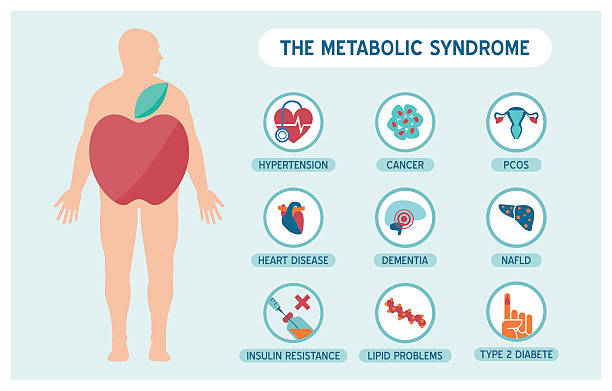What is Metabolic Syndrome?
Metabolic syndrome is a collection of heart disease risk factors that increase your chance of developing coronary heart disease related to plaque buildups in artery walls (e.g., stroke and peripheral vascular disease), stroke, and type 2 diabetes.

According to a national health survey, more than one in five Americans has metabolic syndrome. It’s estimated that over 50 million Americans have it. The number of people with metabolic syndrome increases with age, affecting more than 40 percent of people in their 60s and 70s.
How is the metabolic syndrome diagnosed?
There are no well-accepted criteria for diagnosing the metabolic syndrome. Typically you are diagnosed with metabolic syndrome if you have three or more of the following health risks:
- Elevated waist circumference:
Men equal to or greater than 40 inches (102 cm).
Women equal to or greater than 35 inches (88 cm). - Elevated triglycerides:
Equal to or greater than 150 mg/dL. - Reduced HDL (“good”) cholesterol:
Men less than 40 mg/dL.
Women less than 50 mg/dL. - Elevated blood pressure:
Equal to or greater than 130/85 mm Hg. - Elevated fasting glucose (sugar):
Equal to or greater than 100 mg/dL.
What causes metabolic syndrome?
The exact cause of metabolic syndrome is not known. Many features of the metabolic syndrome are associated with “insulin resistance.” Insulin resistance means that the body does not use insulin efficiently to lower glucose and triglyceride levels. Insulin resistance is a combination of genetic and lifestyle factors. Lifestyle factors include diet, activity and perhaps interrupted sleep patterns (such as sleep apnea).
If a person have metabolic syndrome, what health problems might develop?
Consistently high levels of insulin and glucose are linked to many harmful changes to the body, including:
- Damage to the lining of coronary and other arteries, a key step toward the development of heart disease or stroke.
- Peripheral artery disease.
- Changes in the kidneys” ability to remove salt, leading to high blood pressure, heart disease and stroke.
- An increase in triglyceride levels, resulting in an increased risk of developing cardiovascular disease.
- An increased risk of blood clot formation, which can block arteries and cause heart attacks and strokes.
- A slowing of insulin production, which can signal the start of type 2 diabetes, a disease that is associated with an increased risk for a heart attack or stroke. Uncontrolled diabetes is also associated with complications of the eyes, nerves, and kidneys.
- Nonalcoholic fatty liver disease.
How a person prevents or reverses metabolic syndrome?
Since physical inactivity and excess weight are the main underlying contributors to the development of metabolic syndrome, getting more exercise and losing weight can help reduce or prevent the complications associated with this condition. Your doctor may also prescribe medications to manage some of your underlying problems. Some of the ways you can reduce your risk:
- Lose weight – Moderate weight loss, in the range of 5 percent to 10 percent of body weight, can help restore your body”s ability to recognize insulin and greatly reduce the chance that the syndrome will evolve into a more serious illness. Losing weight so that your body mass index (BMI) is less than 25.
- Exercise – Increased activity alone can improve your insulin levels. Aerobic exercise such as a brisk 30-minute daily walk can result in a weight loss, improved blood pressure, improved cholesterol levels and a reduced risk of developing diabetes. Most health care providers recommend 150 minutes of aerobic exercise each week. Exercise may reduce the risk for heart disease even without accompanying weight loss.
- Consider dietary changes – Maintain a diet that keeps carbohydrates to no more than 50 percent of total calories. Eat foods defined as complex carbohydrates, such as whole grain bread (instead of white), brown rice (instead of white), and sugars that are unrefined (instead of refined; for example cookies, crackers). Increase your fiber consumption by eating legumes (for example, beans), whole grains, fruits and vegetables. Reduce your intake of red meats and poultry. Consume healthy fats such as those in canola oil, olive oil, flaxseed oil, nuts and oily fish.
- Limit alcohol intake – Consume no more than one drink a day for women, or two drinks a day for men.
- Manage your blood pressure and blood sugar.
- Do not smoke.
If you have signs or symptoms of metabolic syndrome call Dr. Villa at 561-627-2912.
